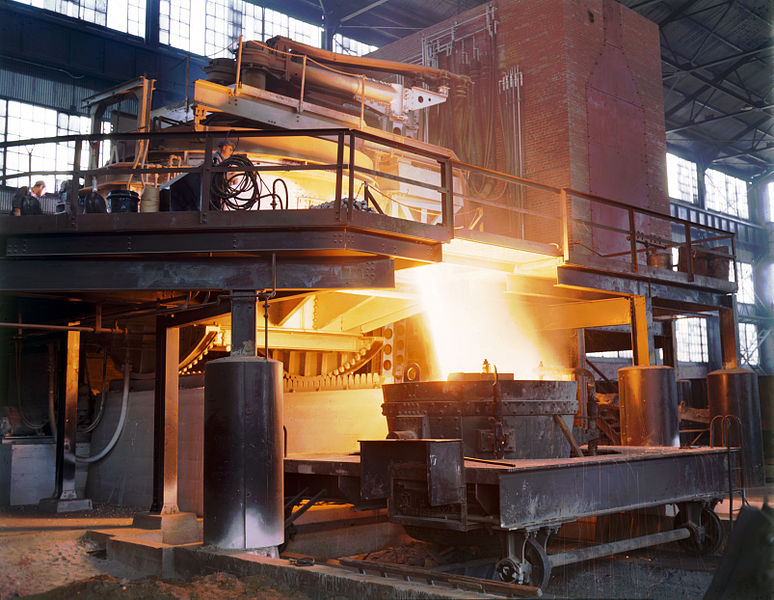 |
Coil Spring
A tension coil spring A coil spring is a mechanical device that typically is used to store energy and subsequently release it, to absorb shock, or to maintain a force between contacting surfaces. It is made of an elastic material formed into the shape of a helix that returns to its natural length when unloaded. Under tension or compression, the material (wire) of a coil spring undergoes torsion. The spring characteristics therefore depend on the shear modulus. A coil spring may also be used as a torsion spring: in this case the spring as a whole is subjected to torsion about its helical axis. The material of the spring is thereby subjected to a bending moment, either reducing or increasing the helical radius. In this mode, it is the Young's modulus of the material that determines the spring characteristics. Spring rate A selection of conical coil springs Spring rate is the measurement of how much load (in pounds) a coil spring can hold until it compresses . The spring r ... [...More Info...] [...Related Items...] OR: [Wikipedia] [Google] [Baidu] |
 |
Computer Keyboard
A computer keyboard is a built-in or peripheral input device modeled after the typewriter keyboard which uses an arrangement of buttons or Push-button, keys to act as Mechanical keyboard, mechanical levers or Electronic switching system, electronic switches. Replacing early punched cards and paper tape technology, interaction via teleprinter-style keyboards have been the main input device, input method for computers since the 1970s, supplemented by the computer mouse since the 1980s, and the touchscreen since the 2000s. Keyboard keys (buttons) typically have a set of characters Engraving, engraved or Printing, printed on them, and each press of a key typically corresponds to a single written symbol. However, producing some symbols may require pressing and holding several keys simultaneously or in sequence. While most keys produce character (computing), characters (Letter (alphabet), letters, Numerical digit, numbers or symbols), other keys (such as the escape key) can prompt the ... [...More Info...] [...Related Items...] OR: [Wikipedia] [Google] [Baidu] |
 |
Timmis System
Timmis was an innovative design of double coiled springs, originally used for railway rolling stock, such as on the Barsi Light Railway c1889, as formulated by Everard Calthrop (1857–1927). Inventor The inventor was Illius Augustus Timmis Patent US Patent 432341 was filled in 1889 and published in 1890. See also * Bogie as used with railway rolling stock. * Coil spring * Leaf spring - an older and simpler system of springs References 1890 introductions Automotive suspension technologies English inventions Springs (mechanical) {{rail-transport-stub ... [...More Info...] [...Related Items...] OR: [Wikipedia] [Google] [Baidu] |
 |
Slinky
The Slinky is a helical spring toy invented and developed by American naval engineer Richard T. James in 1943 and successfully demonstrated at Gimbels department store in Philadelphia on November 27, 1945. It can perform a number of tricks, including travelling down a flight of steps end-over-end as it stretches and re-forms itself with the aid of gravity and its own momentum; and appearing to levitate for a period of time after it has been dropped. These interesting characteristics have contributed to its success in its home country of the United States, and it has inspired many popular toys with Slinky-like components, in a wide range of countries. History Creation In 1943, Richard T. James, a naval mechanical engineer, observed a spring "stepping" downward after being knocked off a shelf, then coming to rest in a vertical position. James's wife Betty later recalled, "He came home and said, 'I think if I got the right property of steel and the right tension, I could ma ... [...More Info...] [...Related Items...] OR: [Wikipedia] [Google] [Baidu] |
|
Shock Absorber
A shock absorber or damper is a mechanical or hydraulics, hydraulic device designed to absorb and Damping ratio, damp shock (mechanics), shock impulses. It does this by converting the kinetic energy of the shock into another form of energy (typically thermal energy, heat) which is then dissipated. Most shock absorbers are a form of dashpot (a damper which resists motion via viscous friction). Description Pneumatic and hydraulic shock absorbers are used in conjunction with cushions and springs. An automobile shock absorber contains spring-loaded check valves and orifices to control the flow of oil through an internal piston (see below). One design consideration, when designing or choosing a shock absorber, is where that energy will go. In most shock absorbers, energy is converted to heat inside the viscous fluid. In hydraulic cylinders, the hydraulic fluid heats up, while in Pneumatic cylinder, air cylinders, the hot air is usually exhausted to the atmosphere. In other types of ... [...More Info...] [...Related Items...] OR: [Wikipedia] [Google] [Baidu] |
|
 |
Leaf Spring
A leaf spring is a simple form of spring (device), spring commonly used for suspension (vehicle), suspension in wheeled vehicles. Originally called a ''laminated'' or ''carriage spring'', and sometimes referred to as a semi-elliptical spring, elliptical spring, or cart spring, it is one of the oldest forms of vehicle suspension. A leaf spring is one or more narrow, arc-shaped, thin plates that are attached to the axle and chassis in a way that allows the leaf spring to flex vertically in response to irregularities in the road surface. Lateral leaf springs are the most commonly used arrangement, running the length of the vehicle and mounted perpendicular to the wheel axle, but numerous examples of transverse leaf springs exist as well. Leaf springs can serve multiple suspension functions: location, springing, and to some extent damping as well, through interleaf friction. However, this friction is not well controlled, resulting in stiction and irregular suspension motions. For t ... [...More Info...] [...Related Items...] OR: [Wikipedia] [Google] [Baidu] |
 |
Bogie
A bogie ( ) (or truck in North American English) comprises two or more Wheelset (rail transport), wheelsets (two Railroad wheel, wheels on an axle), in a frame, attached under a vehicle by a pivot. Bogies take various forms in various modes of transport. A bogie may remain normally attached (as on many railroad cars and semi-trailers) or be quickly detachable (as for a dolly (trailer), dolly in a road train or in railway bogie exchange). It may include Suspension (vehicle), suspension components within it (as most rail and trucking bogies do), or be solid and in turn be suspended (as are most bogies of continuous track, tracked vehicles). It may be mounted on a swivel, as traditionally on a railway carriage or locomotive, additionally jointed and sprung (as in the landing gear of an airliner), or held in place by other means (centreless bogies). Although ''bogie'' is the preferred spelling and first-listed variant in various dictionaries, bogey and bogy are also used. Rail ... [...More Info...] [...Related Items...] OR: [Wikipedia] [Google] [Baidu] |
 |
Tempering (metallurgy)
Tempering is a process of heat treating, which is used to increase the toughness of iron-based alloys. Tempering is usually performed after Hardening (metallurgy), hardening, to reduce some of the excess hardness, and is done by heating the metal to some temperature below the critical point (thermodynamics), critical point for a certain period of time, then allowing it to cool in still air. The exact temperature determines the amount of hardness removed, and depends on both the specific composition of the alloy and on the desired properties in the finished product. For instance, very hard tools are often tempered at low temperatures, while spring (device), springs are tempered at much higher temperatures. Introduction Tempering is a heat treatment technique applied to ferrous alloys, such as steel or cast iron, to achieve greater toughness by decreasing the hardness of the alloy. The reduction in hardness is usually accompanied by an increase in ductility, thereby decreasing the ... [...More Info...] [...Related Items...] OR: [Wikipedia] [Google] [Baidu] |
 |
Hardened Steel
The term hardened steel is often used for a plain-carbon steel, medium or high carbon steel that has been given heat treatment and then quenching followed by tempering (metallurgy), tempering. The quenching results in the formation of metastable martensite, the fraction of which is reduced to the desired amount during tempering. This is the most common state for finished articles such as tools and machine parts. In contrast, the same steel composition in annealing (metallurgy), annealed state is softer, as required for forming and machining. Depending on the temperature and composition of the steel, it can be hardened or softened. To make steel harder, it must be heated to very high temperatures. The final result of exactly how hard the steel becomes depends on the amount of carbon present in the metal. Only steel that is high in carbon can be hardened and tempered. If a metal does not contain the necessary quantity of carbon, then its crystalline structure cannot be broken, and the ... [...More Info...] [...Related Items...] OR: [Wikipedia] [Google] [Baidu] |
 |
Car Suspension
Suspension is the system of tires, tire air, spring (device), springs, shock absorbers and Linkage (mechanical), linkages that connects a vehicle to its wheels and allows relative motion between the two. Suspension systems must support both road holding/Automobile handling, handling and ride quality, which are at odds with each other. The tuning of suspensions involves finding the right compromise. The suspension is crucial for maintaining consistent contact between the road wheel and the road surface, as all forces exerted on the vehicle by the road or ground are transmitted through the tires' contact patches. The suspension also protects the vehicle itself and any cargo or luggage from damage and wear. The design of front and rear suspension of a car may be different. History An early form of suspension on ox-drawn carts had the platform swing on iron chains attached to the wheeled frame of the carriage. This system remained the basis for most suspension systems unti ... [...More Info...] [...Related Items...] OR: [Wikipedia] [Google] [Baidu] |
 |
Upholstery
Upholstery is the work of providing furniture, especially seats, with padding, springs, webbing, and fabric or leather covers. The word also refers to the materials used to upholster something. ''Upholstery'' comes from the Middle English word ''upholder'', which referred to an artisan who makes fabric furnishings. The term is equally applicable to domestic, automobile, airplane and boat furniture, and can be applied to mattresses, particularly the upper layers, though these often differ significantly in design. A person who works with upholstery is called an ''upholsterer''. An apprentice upholsterer is sometimes called an ''outsider'' or ''trimmer''. Traditional upholstery uses materials like coil springs (post-1850), animal hair (horse, hog and cow), coir, straw and hay, hessians, linen scrims, wadding, etc., and is done by hand, building each layer up. In contrast, today's upholsterers employ synthetic materials like dacron and vinyl, serpentine springs, and so on. H ... [...More Info...] [...Related Items...] OR: [Wikipedia] [Google] [Baidu] |